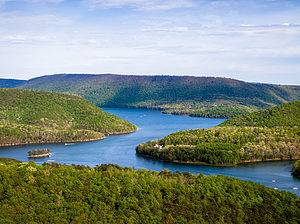Key Points
- No snake species is native to Hawaii; all are invasive
- The Hawaiian Islands have only five natural lakes plus 130 state dams
- No Hawaiian Islands have snake-infested lakes
- Hawaiian yellow-belled sea snakes live in the ocean
Hawaii sits in the Pacific Ocean, 2,000 miles southwest of the United States. Volcanic activity formed this island chain starting 30 million years ago. The remote location of Hawaii necessitated that animals travel across miles of ocean to reach there, effectively keeping most of the world’s large predators at bay. Incredibly, Hawaii hosts a unique but delicate ecosystem that has been enduring the impact of human-introduced species since settlers first landed between the 4th and 7th centuries.
So, what does that mean for snakes? Well, no native land snakes live in Hawaii. Any snakes on the Hawaiian islands, or indeed in Hawaiian lakes, are introduced species. And are there snake-infested lakes in Hawaii? Read on to discover it!
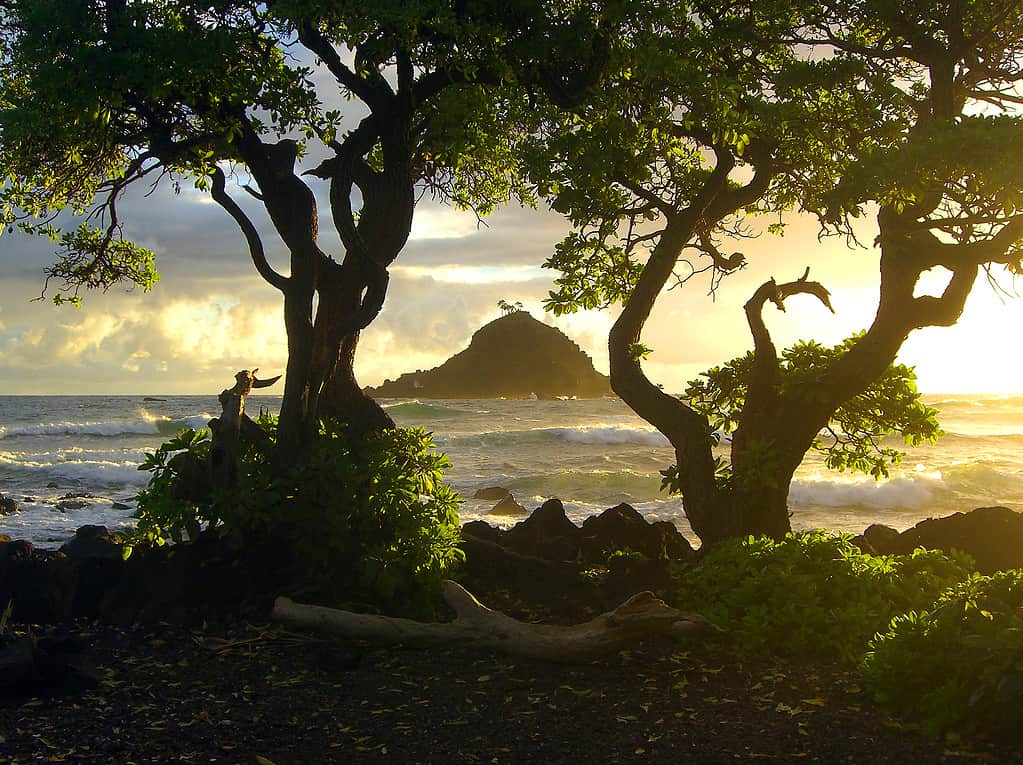
Underwater volcanoes created the Hawaiian Islands starting over 30 million years ago.
©Josh Cornish/Shutterstock.com
Types of Snakes in Hawaii
Are there snakes in Hawaii? Yes, but not natively. There’s a 200,000 dollar fine or a 3-year prison sentence there for anyone caught with a snake (and other invasive species). All of Hawaii’s snakes are invasive species. Here they are.
Brahminy Blind Snake
6-inch-long Brahminy blind snake has lived in Hawaii for so many years it’s considered a native species by some, but it’s not indigenous. It most likely originated from Africa and Asia, carried there by transported cargo.
It’s one of the smallest snake species. Really, they look like large earthworms. These harmless non-venomous burrowing snakes prey on ants and termites in their forested habitats and live beneath rocks and logs.
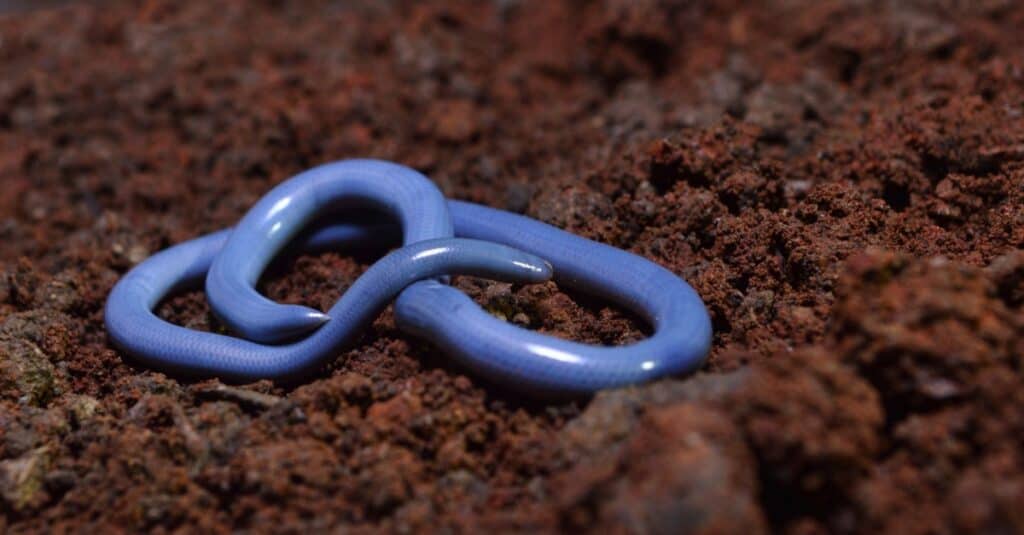
Brahminy blind snakes reach a maximum of 6 inches in length and live beneath rocks and logs.
©RealityImages/Shutterstock.com
Ball Python
Despite Hawaii’s strict regulations, several ball pythons have been spotted. The most recent spotting was in 2020 when a 4-foot-long ball python was captured in Kahalu’u Forest on Oahu Island.
Ball pythons are popular pets in the U.S. with their attractive diamond patterned back and large head. Constrictors, by nature, eat small mammals and birds, so they would cause many environmental problems if they became established in Hawaii.
Boa Constrictor
A few boa constrictor sightings on the Hawaiian Islands have worried officials.
- They were discovered on a farm in 2011, not one but two constrictors (one was 9 feet long).
- A 3-foot-long boa was found slithering across a Honolulu crosswalk in 2013.
- A 5-foot boa constrictor was killed on the Pali highway.
Officials believe these boas were escaped pets.
Garter Snake
An Oregon Christmas tree delivered a live garter snake to Hawaii in 2004, and a second Christmas tree delivered another one in 2020, although it was dead on arrival.
Pretty, stripy garter snakes are common U.S. pets, but they’re not suited to Hawaii’s ecosystem, where its delicate balance of fauna isn’t adapted to hunting snakes.
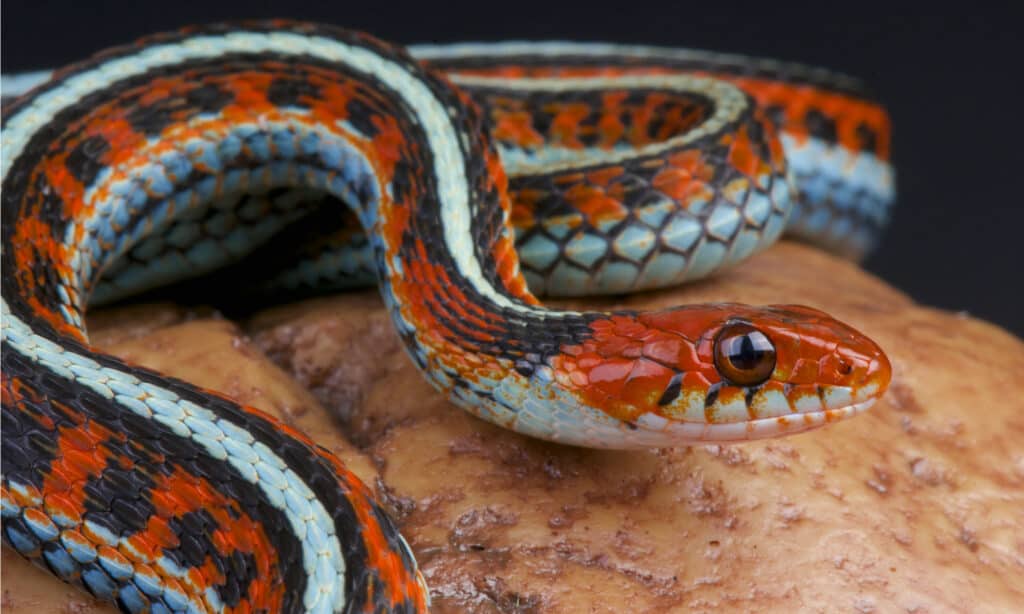
Attractive garter snakes are common pets in the United States.
©reptiles4all/Shutterstock.com
Corn Snake
Nocturnal, non-venomous corn snakes are another popular pet snake, but they grow much larger than garters, up to six feet! Only one has ever been spotted in Hawaii. It was found dead in a backyard.
Corn snakes feed on rodents, small birds, and eggs, so wild corn snakes would cause vast environmental problems in Hawaii.
Brown Tree Snake
Venomous brown tree snakes manage to stow themselves away on cargo vessels between Hawaii and other Pacific Ocean islands.
They can eat 70% of their body weight each day in birds and small mammals. Officials work very hard to ensure they don’t gain a foothold in Hawaii because they could destroy the ecosystem. In 1940 in Guam, many native species disappeared due to this invasive, hungry snake, and it’s now at the top of a food chain it wasn’t designed for.
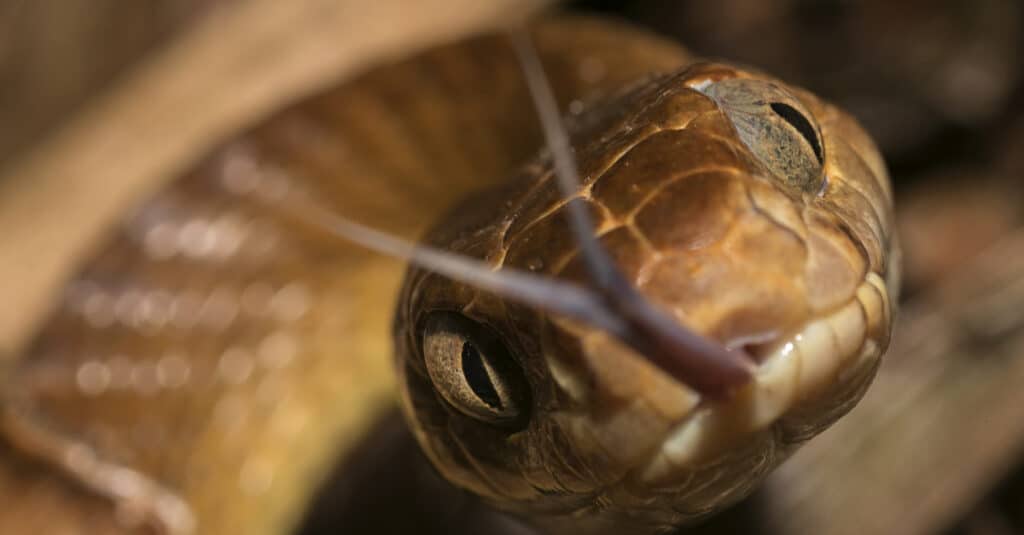
Brown tree snakes travel to Hawaii on Pacific Island cargo ships.
©Firepac/Shutterstock.com
Yellow Bellied Sea Snake
Some experts consider yellow-belled sea snakes native to Hawaii. They live in North America’s open oceans, eating fish and avoiding eagles. It’s pretty obvious where the name comes from! Yellow-bellied sea snakes have yellow bellies, black stripes, and a black and yellow spotted tail.
Venomous sea snakes can harm humans, but there are no reports of this occurring in Hawaii. Although they spend all their time at sea, this snake needs freshwater drinks. It usually gets them from rain that collects on the sea surface.
They can actually live up to 9 months in freshwater, so it’s not completely out of reality bounds that one might turn up in one of Hawaii’s freshwater lakes.
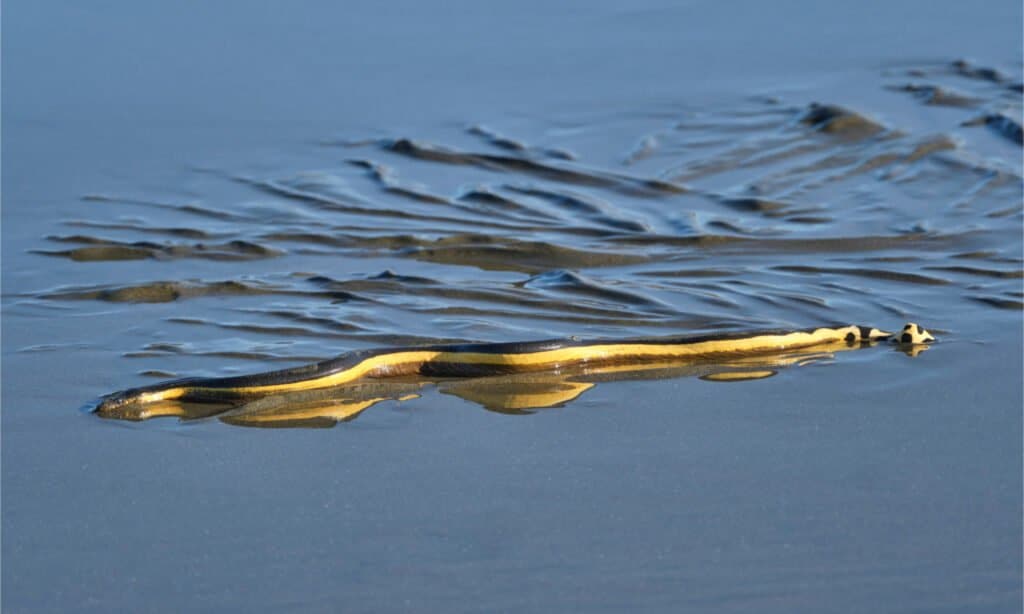
Yellow-bellied sea snakes live in Hawaii’s coastal waters, where they eat fish.
©John Fader/Shutterstock.com
Most Snake-Infested Lakes In Hawaii
Invasive snake species found in Hawaii aren’t water lovers. There aren’t any snake-infested lakes in Hawaii; in fact, the only water-going snake there is the yellow-bellied sea snake, and that particular creature lives in the ocean.
But what other animals live in the lakes?
1 Hālaliʻi Lake
Located in Ni-hau, 840-acre Halali’I Lake becomes the largest Hawaiian lake in the rainy season. It creates a rich wetland habitat for Hawaiian wildlife, including bird species such as the Hawaiian coot and the Hawaiian duck. Locals also use it to farm a fish species called mullet. Rather than fishing with a net or hook, farmers catch grown mullet when the water recedes in summer.
No snake reports here.
2 Lake Waiau
Situated on Hawaii Island, Lake Waiau measures just under 330 feet across, and its level depends on the season. In winter, it ices over, but in the rainy season, it spills out via a stream into the surrounding soil, thus creating an incredible wetland. Again, no snakes but plenty of birds, insects, and fish.
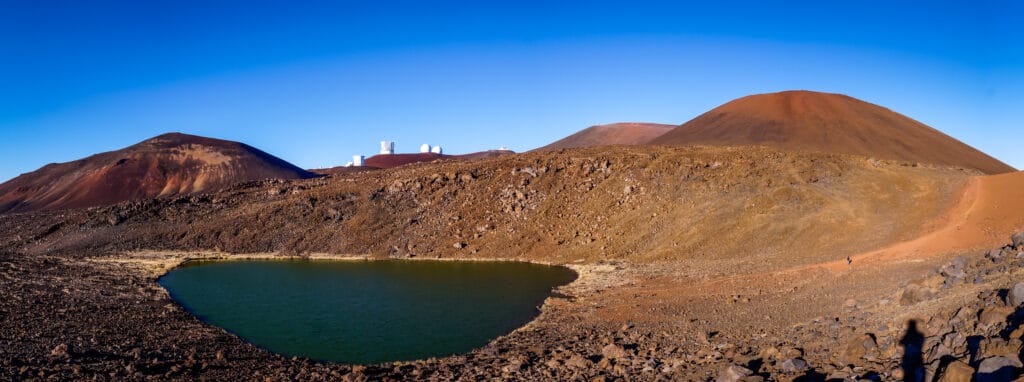
Lake Waiau in Hawaii grows in the rainy season and ices over in winter.
©Julian Peters Photography/Shutterstock.com
3. Laysan Lake
In Laysan Island’s center lies Laysan Lake. Its salinity is three times that of the ocean, and white, sandy beaches surround it. Laysan covers 100 acres and reaches 30 feet deep.
Seabirds and saltwater fish inhabit this lake, but there are no reports of yellow-bellied sea snakes despite the salt water. Small pockets of trapped fresh water encourage land birds like finches to its shores.
4. Violet Lake
Surrounded by dense rainforest is Violet Lake on Maui Island. It’s a hiker’s paradise because it’s a trek from the roads and surrounded by incredible flora and fauna, for example, the Maui violet and the Hawaiian damselfly Megalagrion.
Local legend says this beautiful lake is where heaven and earth meet.
Again, no snakes.
5. Halulu Lake
Ni-ihau island’s largest non-intermittent lake expands over 180 acres in the rainy season and shrinks in the dry season so significantly that the lake bed leaves a reddish stain.
Like neighboring Halali’i Lake, it attracts Hawaiian ducks and coot, plus birds, insects, and any invasive animals that need to drink, such as cats, dogs, pigs, goats, and cattle.
But no snakes.
Alongside Hawaii’s five natural lakes, there are 130 man-made reservoirs. Are these snake infested?
6. Waita Reservoir
425-acre Waita reservoir was built in the early 1900s to irrigate cane sugar crops. It’s one of Hawaii’s largest inland bodies of fresh water and quite a tourist attraction with its 2,500-foot-long zip wire.
Its beautiful surrounding forest was used as the backdrop to Jurassic Park, and it’s home to insects like butterflies, damselflies, birds, and many fish species, including bass and blue tilapia.
No snake reports here.
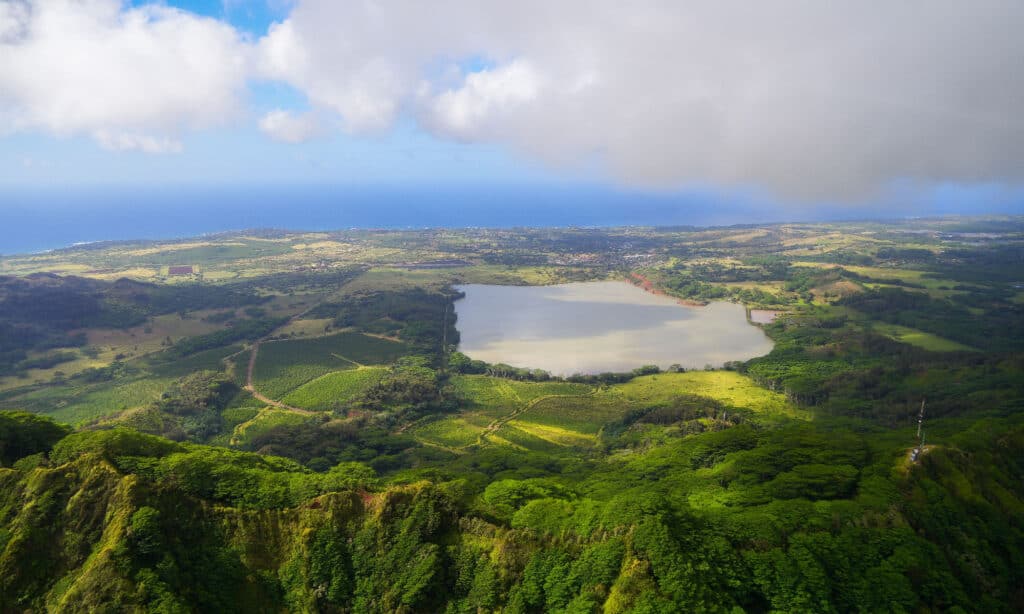
Waita Reservoir is snake-free and provides a 2,500 feet zipline.
©Alexandre G. ROSA/Shutterstock.com
7. Kahalu’u Pond
One of very few surviving royal fishponds on Oahu island, Kahalu’u Pond provided the backdrop to films like The Karate Kid. Nearly Kanaha Pond State Wildlife Sanctuary takes care of it.
Fish enjoy these waters in peace (it’s illegal to catch fish here because it has nationally protected status), so enjoy the view from an officially licensed tourist bus instead.
On a good day, you’ll see 90 bird species, including sandpipers, brown koloa ducks, plovers, and seasonal Canada geese. You won’t see snakes, though. There aren’t any snakes at Kahalu’u Pond.
8. He’eia Fishpond
Another royal fish pond saved from destruction is He’eia Fishpond on Oahu. Again, it’s illegal to fish here, but the water is packed with koi, six-finger threadfin, Hawaiian ladyfish, plus crabs, shrimp, and even eel.
The U.S National Register of Historic Places protects this walled coastal pond constructed between 1200 and 1400 CE. You won’t be surprised to hear that no snakes reside at this protected fish pond, but you will spot endangered birds.
Are There Any Dangerous Animals in Hawaii?
Hawaii has no snake-infested lakes because there are no snake populations, just isolated incidents of escaped pets or snakes transferred by cargo. It’s a nope-rope hater’s paradise for sure, but what dangerous animals do live in Hawaiian waters?
Lots of dangerous animals lurk in Hawaii’s warm coastal waters alongside the yellow-bellied sea snakes we’ve already encountered. Let’s take a look:
Sharks
Warm Pacific Ocean waters tempt sharks to the Hawaiian Islands and not just tiddlers. Some epic sharks include great whites, bull sharks, hammerheads, and tiger sharks. While attacks are rare, it’s worth paying attention to the surrounding coastal water if you fancy a swim.
Crown of Thorns Starfish
This giant sea creature consumes coral and delivers a toxic sting to any creature that treads on it. The Crown of Thorns starfish sting is very painful. Its toxin lasts up to three hours, causing nausea, weakness, vomiting, headache, cough, and rarely, paralysis.
This 15-inch wide sci-fi-type creature’s venomous spines can lacerate diving suits.
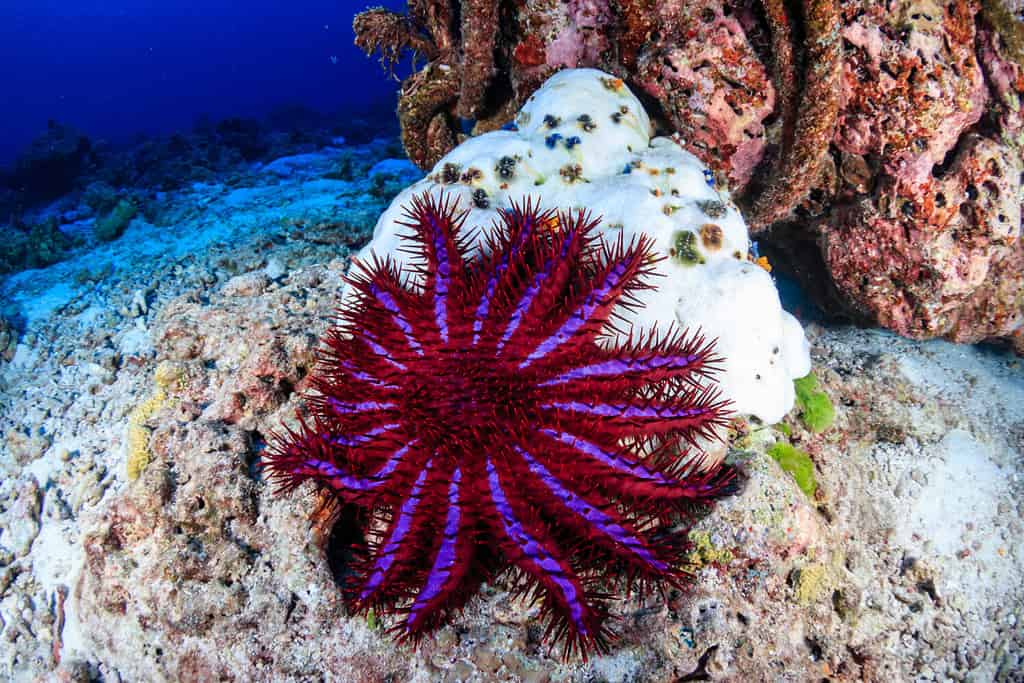
Crown of Thorns starfish eat coral and deliver a painful sting that can lacerate wetsuits.
©Richard Whitcombe/Shutterstock.com
Centipedes
Hawaii’s centipedes‘ toxic bite causes burning, swelling, nausea, vomiting, and breathing difficulties. They usually live in forested areas but enjoy the misty surroundings of Hawaii’s lakes. Keep your eyes peeled for centipedes, and do not touch them.
Box Jellyfish
Box jellyfish are the most common jellyfish species in Hawaii. Their tentacles reach up to two feet long and inflict an incredibly painful sting on their victims.
Box jellyfish sting symptoms include swelling, breathing problems, burning sensations, and nerve end damage. On smaller prey, it incapacities them so badly the jellyfish can consume them at leisure. In humans, it can be enough to cause death. 50-100 people die annually from box jellyfish stings. Experts say their toxic venom makes them the most dangerous creatures in Hawaii.
Cone Snail
A dangerous snail, no!
Yes. A carnivorous cone snail impales their unfortunate victim with lethal toxins. The larger species harpoon venom that’s so painful it feels as if your limbs are on fire.
Hawaii is home to 30 species, and their shells are very attractive. This has led to collectors picking them up and receiving an incapacitating sting. Nerve-ending damage is probable, so a medical visit is essential.
Cone snails are ocean goers. They live in coral reefs beneath boulders and in the coastal sands. They don’t live in lakes.
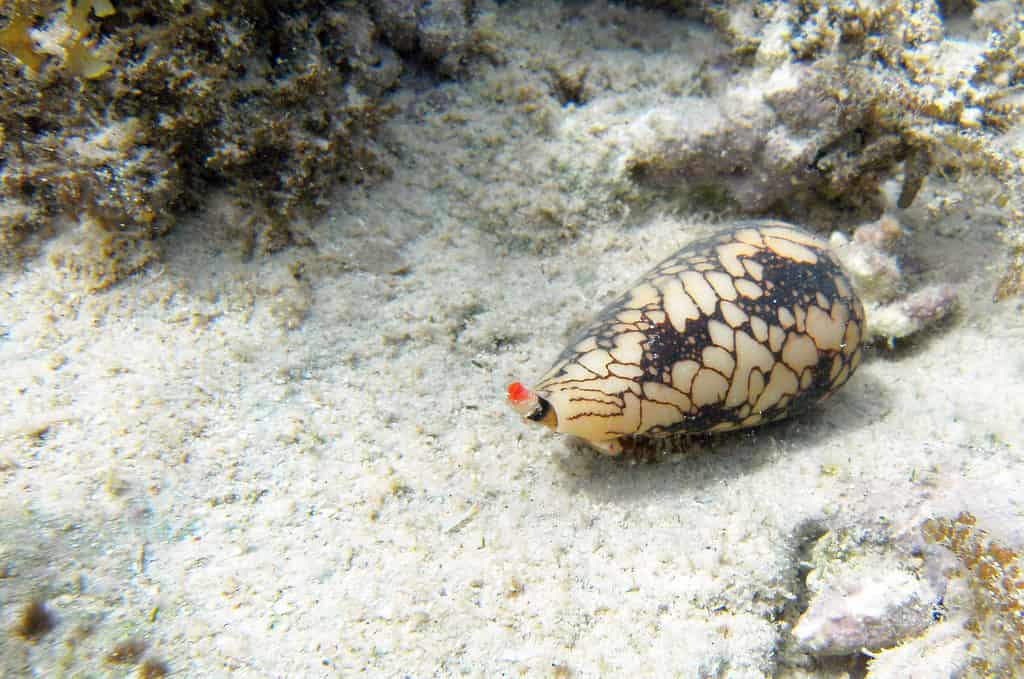
Pretty-shelled cone snails inject venom with their sharp harpoon.
©O’KHAEN/Shutterstock.com
Hawaii’s Snake-Infested (Or Not) Lakes
So, we’ve discovered that Hawaii’s lakes are not infested with snakes. No snakes live in natural or man-made freshwater bodies there.
The closest we get to it is the yellow-bellied sea snake, but this venomous snake is an ocean resident. In theory, one could live in freshwater for nine months, but it is not something that’s ever reported.
Snakes in Hawaii are there by accident, or they’re escaped pets. The ecosystem is not designed to house predator snakes, and the government works hard to eradicate any that appear. A Hawaiian lake trip might be your perfect holiday destination if you’re a danger-noodle phobic.
The photo featured at the top of this post is © Cody A Seymour/Shutterstock.com
Thank you for reading! Have some feedback for us? Contact the AZ Animals editorial team.





